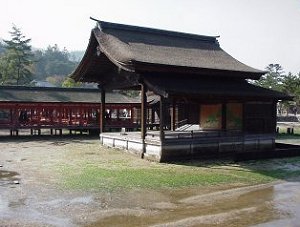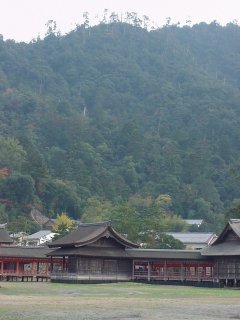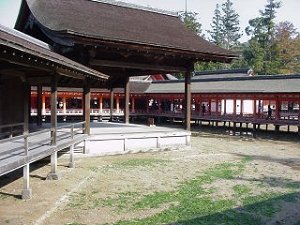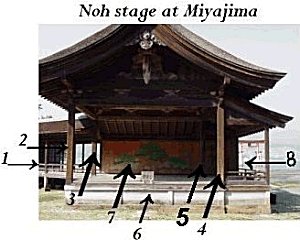Noh |
Written in Japanese using two ideograms (kanji):

 Nou (pronounced as in yes/no) has a number of meanings.
In this context, it is usually translated as refined.
Which is fitting, as Noh was adopted as a past-time of the military elite from the early 1600s onwards.
Nou (pronounced as in yes/no) has a number of meanings.
In this context, it is usually translated as refined.
Which is fitting, as Noh was adopted as a past-time of the military elite from the early 1600s onwards.
 gaku is the suffix for entertainment.
It appears in a number of phrases relating to theatre.
gaku is the suffix for entertainment.
It appears in a number of phrases relating to theatre.
Noh is generally associated with the Kansai area in central Japan, particularly the ancient capital of Nara.
There are however two main venues in the Hiroshima area. |
Itsukushima Jinja
This is a photo of the Noh stage at Itsukushima Shrine,
Miyajima (Island) . The area has been a religious center since construction began in 593.
The stage itself is designated as a national treasure. |
 |
 |
The building is notable for several reasons.
Firstly the way in which the link between nature and the stage has been maintained
- a difficult task for urban playhouses.
The shrine itself is built in such a way that parts of the grounds flood at high tide.
The area between the stage and the audience (known as the shirasu), is usually filled with a virtual moat of white pebbles.
In this case however, it periodically becomes a real one! |
There are no seats for the spectators -
they watch from a distance, standing or sitting beneath a covered walkway. |
 |
The Stage

This photo shows a few of the stage landmarks.
The green room is separated from the stage proper by a covered walkway
(1) known as the hashi-gakari. The roof of the stage is held up by four columns.
The downstage right pillar (2) is known as the mi-tsuke or eye-catching pole.
This is used as a landmark by the actors, who often have virtually no vision,
due to the narrow eye-hole slits on the masks. The shite pillar
(3) serves as 'home base' for the principle actor (shite) following his entrance.
Downstage left is the waki-bashira (4), the column closest to where the foil (waki)
sits for the majority of the play. Upstage left is the fue bashira
(5), the pole just in front of where the flute (fue) player sits.
The orchestra also typically includes a small, medium and large drum.
Normally, there is a short flight of steps (the shirashu-bashigo) linking the pebble moat
with the front of the stage (6). However, Itsukushima's watery location precludes this.
The back of the stage is illustrated with the obligatory pine tree
(7), although in this case, the setting renders it redundant.
Stage left (8) is the alcove for the chorus (the ji-utai).
|
Astel Plaza
The urban alternative to Itsukushima is Astel Plaza,
a down-town multi-purpose performance space. A noh stage has been recreated indoors,
exact in every detail, including the roof, the three pines in front of the hashi-gakari,
and the pebble moat. The seating is modern/western, and the lighting is artificial.
Performances often start at 10:00 am and run until about 5:00 pm.
links
A number of excellent website are available with more information on Noh theatre.
The
University of Virginia library is a great place to start.
It provides an history/overview, as well as stage diagrams and a number of full-text plays
(in English). Another good introduction can be found
here
, although most of the pages are in Japanese. The
University of Sydney
offers an interesting paper on Noh and dancing. There are also a number of pages related to Noh masks - try
here or
here.
Marilyn Turkovich and Linda Babolz offer some information on the differences between Noh and Kabuki.
And short quicktime excerpts of a performance can be downloaded from
this site.
|
|



